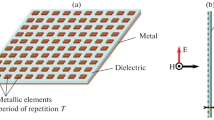Abstract
In this paper, a theoretical analysis of scattering from a doubly frequency selective surfaces (FSS) with dielectric and metallic losses in the millimeter wave range is presented. The theoretical analysis involves the solution of the electric field integral equation relating the induced current in the FSS in the presence of anisotropic dielectric layers. The method of moment is employed to obtain numerical results. The frequency selective surface structure considered is composed by conducting patch elements sandwiched between two anisotropic dielectric layers. Three different anisotropic materials are considered: Epsilam-10, Alumina, and Sapphire. The sapphire presents low losses when compared with the other two dielectric materials. The most common metals, as copper and aluminum, are considered in this analysis. None significant metallic losses were observed for any considered metal. Numerical results are presented for the scattering characteristics and for dielectric and metallic losses parameters.






Similar content being viewed by others
References
R. Mittra, C. H. Chan, and T. Cwik, Techniques for analyzing frequency selective surfaces-a review. IEEE Proceedings 76, 12 (1988).
T. K. Wu, Frequency selective surface and grid array. (Jonh Wiley & Sons, New York, 1995).
B. A. Munk, Frequency Selective Surfaces: Theory and Design. (Jonh Wiley & Sons, New York, 2000).
J. C. Vardaxoglou, Frequency Selective Surface: Analysis and Design. (Jonh Wiley & Sons, New York, 1997).
D. W. Porterfield, J. L. Hesler, R. Densing, E. R. Mueller, T. W. Crowe, and R. M. Weikle II, Resonant metal-mesh bandpass filters for the far infrared. Applied Optics 33, 25 (1994).
R. Hall, and R. Mittra, Scattering from a periodic array of resistive strips. IEEE Trans. Antennas Propag 33, 9 (1985).
T. Cwik, and R. Mittra, Scattering from a periodic array of free-standing arbitrarily shaped perfectly conducting or resistive patches. IEEE Trans Antennas Propag 35, 11 (1987).
G. I. Kiani, A. R. Weily, and K. P. Esselle, Frequency Selective Surface Absorber using Resistive Cross-Dipoles. IEEE Antennas and Propagation Society International Symposium, (2006).
T. Schimert, M. E. Koch, and C. H. Chan, Analysis of Scattering from Frequency Selective Surfaces in the Infrared. J. Opt. Soc. Am. 7, 8 (1990).
J. A. Bossard, L. Li, J. A. Smith, D. H. Werner, T. S. Mayer, R. P. Drupp, and Y. Tang, Terahertz applications of frequency selective surfaces: analysis, design, fabrication and testing. IEEE Antennas and Propagation Society International Symposium, (2006).
H. T. Liu, H. F. Cheng, Z. Y. Chu, and De-Yong. Zhang, Absorbing properties of frequency selective surface absorbers with cross-shaped resistive patches. Mater. Des. 28, 7 (2007).
M. Kominami, H. Wakabayashi, S. Sawa, and H. Nakashima, Scattering from a periodic array of arbitrary shaped elements on a semiinfinite substrate. Electron. Commun. Jpn (Part I: Communications) 77, 1 (2007).
M. Gustafsson, RCS reduction of integrated antenna arrays with resistive sheets. J. Electromagn. Waves Appl 20, 1 (2006).
A. L. P. S. Campos, Analysis of FSS with Dielectric Losses at Millimeter Wave Band Using the Transverse Transmission Line Method. Int. J. Infrared Millim. Waves 28, 2 (2007).
A. L. P. S. Campos, Transverse transmission line method to analyze stop-band microwave filters. Microw. Opt. Technol. Lett. 49, 11 (2007).
J. A. Buck, and W. H. Hayt, Engineering Electromagnetics. (Mcgraw-Hill Professional, New York, 2004).
Z. Y. Shen, High-Temperature Superconductors Microwave Circuits. (Artech House inc., Boston, 1994).
Z. Xiaoxia, P. Wei, and S. Lucyszyn, A New Theoretical Modeling of Surface Resistance in Normal Metals at Terahertz Frequencies. Int. J. Infrared Millim. Waves 25, 11 (2004).
J. J. Barroso, P. J. Castro, and J. P. Leite Neto, Electrical Conductivity Measurement Through the Loaded Q Factor of a Resonant Cavity. Int. J. Infrared Millim. Waves 24, 1 (2003).
A. Nakayama, A. Fukuura, and M. Nishimura, Millimeter-wave measurement of complex permittivity using dielectric rod resonator excited by NRD-guide. IEEE Trans. Microwave Theor. Tech. 51, 1 (2003).
A. C. César, Analysis Of Anisotropic Nonradiative Dielectric (Nrd)-Guides Using Coupled-Mode Theory. XXVIIth General Assembly of the International Union of Radio Science, (2002).
B. Bhat, and S. K. Koul, Analysis, design and applications of fin lines. (Artech House inc., Boston, 1987).
T. F. Eibert, J. L. Volakis, D. R. Wilton, and D. R. Jackson, Hybrid FE/BI modeling of 3-D doubly periodic structures utilizing triangular prismatic elements and an MPIE formulation accelerated by the Ewald transformation. IEEE Trans. Antennas Propag. 47, 5 (1999).
Author information
Authors and Affiliations
Corresponding author
Rights and permissions
About this article
Cite this article
Campos, A.L.P.d.S. Analysis of Frequency Selective Surfaces with Metallic and Dielectric Losses at Millimeter Wave Range. Int J Infrared Milli Waves 29, 684–692 (2008). https://doi.org/10.1007/s10762-008-9356-7
Received:
Accepted:
Published:
Issue Date:
DOI: https://doi.org/10.1007/s10762-008-9356-7




